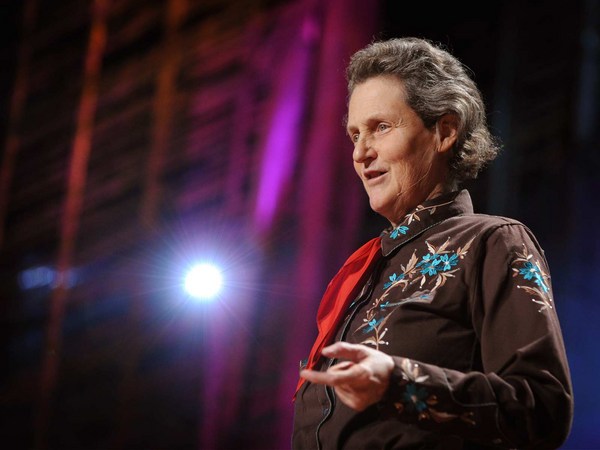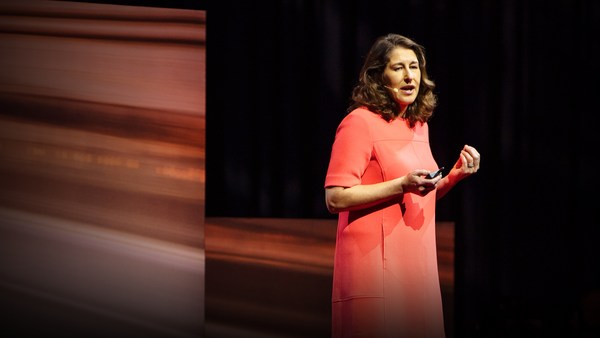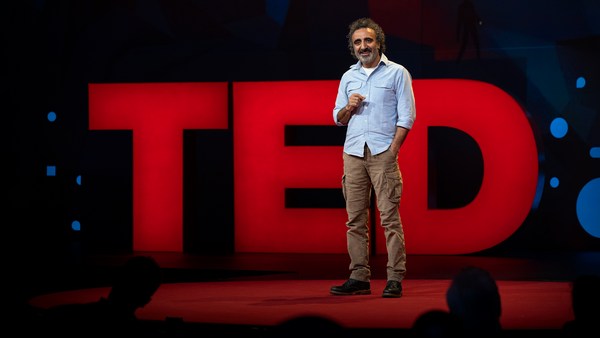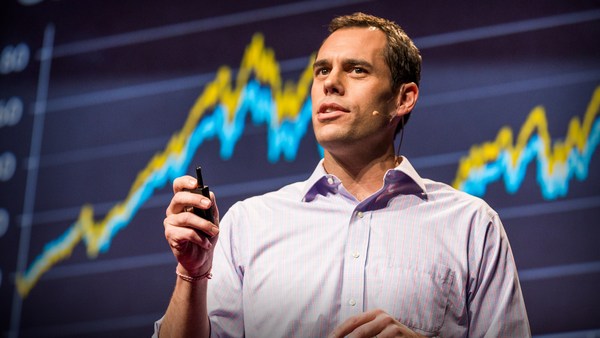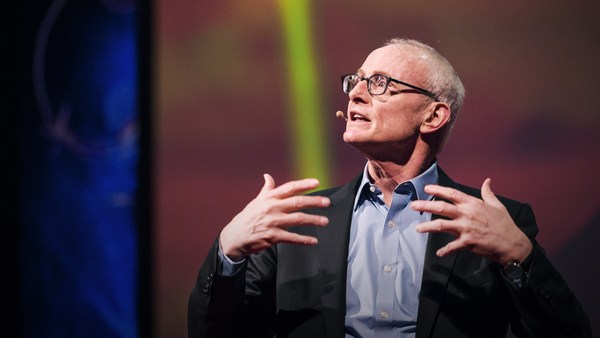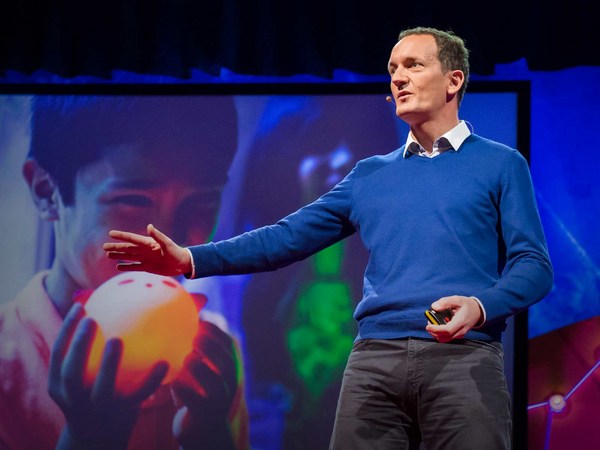Who remembers this infamous Styrofoam container?
(Applause)
Well, it sure changed me, it changed my company, and it started a revelatory journey about how adversaries can be your best allies. You know, back in the late '80s, this Big Mac clamshell was the symbol of a garbage crisis. People were really angry. For example, thousands of students, young students around the globe were sending letters, blaming McDonald's, because we were using millions of these at that time. Now, no one at McDonald's knew anything about environmentally friendly packaging, including me. The last 10 years, I was in charge of logistics and truck drivers. Then out of nowhere, my boss comes to me and says, "Hey, we want you to save this clamshell for the company and lead the effort to reduce waste within McDonald's." I looked at him and I asked him, "What is polystyrene?" But it all sounded intriguing to me because it brought me back to my roots.
You see, I grew up in the late '60s, early '70s, in a time of huge social upheaval in the United States. And I was really in tune with the protests, the sit-ins, the anti-Vietnam sentiment, and I really felt there was a need to question authority. But as I went into university, I realized that I'm not going to make a living doing this. And that whole movement had subsided, and my activist spirit went dormant. And I needed to make a living, so I got involved in the business world. So, now these students against pollution, who were sending those protest letters to McDonald's, they reminded me of myself 20 years ago. They're questioning authority. But now, I'm the man.
(Laughter)
I'm the corporate suit. I'm the one representing authority. And this new thing was emerging called corporate social responsibility, later corporate sustainability, and now I had a chance to make a difference. So the beginning of this journey started when McDonald's agreed to a partnership with the Environmental Defense Fund. They were an NGO that was founded with the principle of "sue the bastards." So I'm thinking, what are they thinking about me and my team?
When I first met Richard Denison, he's the senior scientist for EDF, I was very apprehensive. I thought he's a tree-hugger, and I'm thinking he thinks all I care about is the money. So we wanted the EDF team to give us real-world solutions. So we did the logical thing. We had them flip burgers in our restaurants. So you have to imagine Richard, who, by the way, is a PhD in physics, and there he is, he's trying to dress a quarter-pounder, and you're supposed to have two squirts of ketchup, one mustard, three pickles and an onion, go on to the next one, you've got to be so fast. And you know what? He couldn't get it right all day long. And he was frustrated. And I was so impressed, because he was trying to understand our business.
Now, the EDF team, they thought reusables were the holy grail for our business. Me and my team thought, reusables? Too much space, they'd make a mess, they would slow us down. But we didn't reject the idea. We went to the restaurant they chose outside DC, we went to the back room. The dishwasher wasn't working properly, it's spitting out dirty dishes. The kitchen area is dirty and grimy. And compared to their experience at McDonald's that's clean and organized, they could see the stark difference. We also sat in a restaurant at McDonald's, all day long, and watched the customers eating in. Their behavior. Ends up that many customers left with the food, they left with the beverage. And EDF came to their own conclusion that reusables wouldn't work for us.
But they did have a lot of ideas that did work. And we never would have thought of them by ourselves, without the EDF team. My favorite was switching from the white carry-out bag to the brown bag. We had been using the white bag. It's virgin material, it's made from chlorine bleaching chemicals, and they said, use an unbleached bag, no chemicals. It's made from recycled content, mostly recycled shipping corrugated boxes. Ends up that the bag is stronger, the fiber is stronger, it didn't cost us more money. It was win-win.
Another idea they had was that we could reduce our napkin by one inch. And make it from recycled office paper. I'm thinking, one inch, no big deal. We did it, it reduced waste by three million pounds a year. Sixteen thousand trees saved.
(Applause)
What was really cool is we changed that bright white napkin, because the recycled content became gray and speckled. And we made that look, you know, in tune, in vogue with customers. So, I came to really enjoy the time working with the EDF team. We had many dinners, late-night discussions, we went to a ball game together. We became friends.
And that's when I learned a life lesson. That these NGO crusaders, they're really no different than me. They care, they have passion, we're just not different. So, we had a six-month partnership that ended up producing a 42-point waste reduction action plan. To reduce, reuse, recycle. We measured it during the decade of the '90s, and over 10 years we reduced 300 million pounds of waste. Now, if you're wondering about that polystyrene clamshell, yeah, we ditched it. And luckily, I still had a job.
And this partnership was so successful that we went on to recycle the idea to work with critics. Collaborate with them on solutions that could work for society and for business. But could this idea of collaborating work with the most contrarian folks? And on issues that are, you know, not within our direct control. Like animal rights.
Now, animal rights, obviously they don't want animals used for meat. McDonald's, probably the biggest purchaser of meat in the food service industry. So there's a natural conflict there. But I thought it would be best to go visit and learn from the most vociferous and vigilant critics we had at that time, which were Henry Spira, head of Animal Rights International, and Peter Singer, who wrote the book "Animal Liberation," which is considered the modern treatise about animal rights. You know, I read Peter's book to prepare, I tried to get into his mindset, and I have to admit, it was tough, I'm not becoming a vegan, my company wasn't going that way. But I really thought we could learn a lot.
And so I set up a breakfast meeting in New York City. And I remember sitting down, getting ready, and I decided I'm not going to order my favorite, which is you know, bacon and sausage and eggs.
(Laughter)
And I'm just going to stick to the pastries. But I have to admit, I was waiting for the adversarial discussion to happen. And it never did. Henry and Peter were just gracious, they were caring, they were smart, they asked good questions. I told them about how working on animal welfare is very tough for McDonald's because our direct suppliers, they only make meat patties. The animals are three or four steps removed from our influence. And they were very empathetic. And while we were so directly opposed in terms of the missions of our organizations, I felt that I had learned a lot.
And best of all, they gave me a terrific recommendation. And that is, they said, "You should work with Dr. Temple Grandin." Now, I didn't know her at the time. But I tell you, she's the most renowned expert, then and now, on animal behavior. And she knows how animals move and how they should react in facilities. So I end up meeting her, and she's the very best type of critic, in a sense that she just loves the animals, wants to protect them, but she also understands the reality of the meat business. And I'll always remember, I had never been to a slaughterhouse in my life, and so I go with her for my first trip. I didn't know what to expect. And we find that the animal handlers have electric prods in their hands, and are basically zapping almost every animal in the facility. We're both appalled, she's jumping up and down, you'd have to know her, she's saying, "This can't be, this isn't right, we could use flags, we could use plastic bags, we could redesign the corrals for natural behavior."
Well I set up Temple with our suppliers to set up standards and guidelines. And ways to measure her ideas of implementing animal welfare. We did this for the next two to five years. And it all got integrated, it all got enforced. By the way, two of McDonald's suppliers lost business because they didn't meet our standards. And best of all, all these standards ended up scaling to the entire industry. And no more zapping of those animals.
Now, what about issues that we're blamed for elsewhere? Like deforestation. You know, on that issue, I always thought, policy makers and government, that's their role. Never thought it would end up in my lap. But I remember in early April 2006, I opened up my Blackberry, and I'm reading about Greenpeace campaigners showing up in the UK by the dozens, dressed as chickens, having breakfast at McDonald's and chaining themselves to the chairs and tables. So they got a lot of attention, including mine. And I was wondering if the report that they had just released, it was called "Eating Up the Amazon." And by the way, soy is a key ingredient for chicken feed, and that's the connection to McDonald's.
So I called my trusted friends at the World Wildlife Fund, I called Conservation International, and I soon learned that the Greenpeace report was accurate. So I gathered internal support, and I'll always remember, next day, after that campaign, I called them up, and I said, "We agree with you." And I said, "How about working together?" So three days later, miraculously, four people from McDonald's, four people from Greenpeace, we're meeting in the London Heathrow airport. And I have to say, the first hour was shaky, it wasn't a whole lot of trust in the room. But it seemed like everything came together, because each of us wanted to save the Amazon. And during our discussions, you couldn't really tell, I don't think, who was from Greenpeace and who was from McDonald's.
So one of the best things we did is we traveled with them for nine days on a trip through the Amazon, on the Greenpeace airplane, on the Greenpeace boat. And I'll always remember, imagine traveling hundreds of miles west of Manaus, the capital city of the Amazon. And it's so pristine beauty, there's no man-made structures, there's no roads, not one wire, not one house. You would travel east of Manaus and you would see the blatant rainforest destruction. So this very unlikely collaboration produced outstanding results. By working together, we recruited over a dozen other retailers and suppliers for the same cause. And by the way, within three months, a moratorium on these clear-cutting practices was announced by the industry. And Greenpeace themselves declared it as a spectacular drop in deforestation and it's been in effect ever since.
Now, you think these types of collaborations that I've described would be commonplace today. But they're not. When organizations are battered, the common response is to deny and push back, put out some sort of lame statement and no progress is made at all. I say the alternative is really powerful. I mean, it's not going to fix every problem, and there's more to do for sure, but this idea of working with critics and trying to do more good for society that actually is good for business, believe me, it's possible. But it starts with the idea that you need to assume the best intentions of your critics. Just like you have the best intentions. And then secondly, you need to look past a lot of these tactics. I admit, I did not like a lot of the tactics used on my company. But instead, focus on what the truth is, what's the right thing to do, what's the science, what's the facts. And lastly, you know, I would say, give the critics the keys. Show them the back room. Bring them there, don't hide the details, because if you want allies and support, you need to be open and transparent.
Now, whether you're a corporate suit, whether you're a tree-hugger, I say the next time you're criticized, reach out, listen, learn. You'll become better, your organization will become better, and you might make some good friends along the way.
Thank you.
(Applause)
